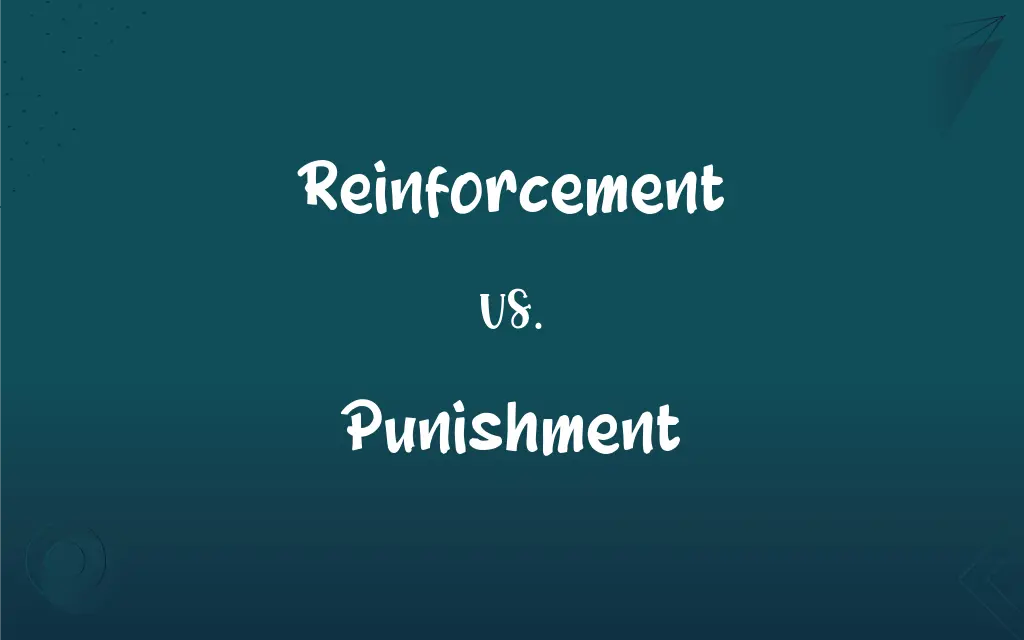Reinforcement vs. Punishment: What's the Difference?
Edited by Aimie Carlson || By Harlon Moss || Updated on October 26, 2023
Reinforcement encourages behavior through rewards or removal of unpleasant stimuli, while punishment discourages behavior through negative outcomes or the introduction of adverse stimuli.

Key Differences
Reinforcement and punishment are both principles rooted in behavioral psychology, aimed at influencing behavior. Reinforcement seeks to increase the likelihood of a behavior by adding a positive stimulus or removing a negative one after the behavior occurs. Conversely, punishment aims to decrease the likelihood of a behavior by introducing a negative stimulus or removing a positive one following the behavior.
The essence of reinforcement is to motivate and encourage certain behaviors. It can be in the form of praise, rewards, or any other incentives that would make a person more likely to repeat a behavior. In contrast, punishment is about deterring or reducing undesired behaviors, often by introducing consequences or unfavorable outcomes.
Positive reinforcement involves giving a rewarding stimulus after a behavior, making the behavior more likely to occur in the future. For instance, giving a child candy for completing their homework is a form of positive reinforcement. In contrast, positive punishment entails introducing an unfavorable stimulus following a behavior, like scolding a child for breaking a vase.
Negative reinforcement is about removing an unfavorable stimulus after a behavior, making that behavior more probable in the future. For instance, taking painkillers to relieve a headache reinforces the behavior of taking medication when in pain. On the other side, negative punishment involves removing a favorable stimulus after a behavior, like confiscating a toy when a child misbehaves.
Both reinforcement and punishment play pivotal roles in shaping behaviors. They are tools used by educators, parents, employers, and therapists to guide actions and reactions. While reinforcement focuses on encouragement, punishment is centered on deterrence.
ADVERTISEMENT
Comparison Chart
Purpose
Increase the likelihood of behavior.
Decrease the likelihood of behavior.
Method
Add a positive stimulus or remove a negative one.
Introduce a negative stimulus or remove a positive one.
Example (Positive)
Giving a treat to a dog for sitting (Positive Reinforcement).
Scolding a dog for barking at guests (Positive Punishment).
Example (Negative)
Removing chores when a child finishes homework early (Negative Reinforcement).
Taking away a child's video game for not doing chores (Negative Punishment).
Focus
Encouragement of behavior.
Deterrence of behavior.
ADVERTISEMENT
Reinforcement and Punishment Definitions
Reinforcement
Reinforcement emphasizes rewards or the removal of undesired consequences.
Getting a dessert after eating vegetables is reinforcement for kids.
Punishment
Punishment can introduce negative consequences or remove positive ones.
Being fined for littering is a punishment meant to deter the act.
Reinforcement
Reinforcement is a fundamental principle in behavioral psychology.
Training animals often involves the use of treats as reinforcement.
Punishment
Punishment is used to discourage certain actions.
A student might think twice about cheating if they know the punishment is failing the course.
Reinforcement
Reinforcement aims at behavior repetition.
Students studying more when praised for good grades is a result of reinforcement.
Punishment
Punishment is another key principle in behavioral psychology.
Prison sentences are forms of punishment for breaking laws.
Reinforcement
Reinforcement is a process to increase desired behaviors.
Earning a bonus at work for good performance is a form of reinforcement.
Punishment
Punishment is a process to decrease undesired behaviors.
A child being grounded for not doing homework is a form of punishment.
Reinforcement
Reinforcement can be either positive or negative.
Using an umbrella to avoid getting wet in the rain reinforces the behavior of carrying one.
Punishment
Punishment aims at behavior deterrence.
Increasing taxes on unhealthy foods is a punishment to decrease consumption.
Reinforcement
The act or process of reinforcing or the state of being reinforced.
Punishment
The imposition of a penalty or deprivation for wrongdoing
The swift punishment of all offenders.
FAQs
What is reinforcement?
Reinforcement is a method to increase the likelihood of a behavior by adding rewards or removing unpleasant stimuli.
How does positive reinforcement work?
It involves giving a rewarding stimulus after a behavior to make it more likely to recur.
What does punishment entail?
Punishment aims to decrease the likelihood of a behavior by introducing negative outcomes or removing positive stimuli.
Is all punishment harmful?
Not necessarily; when used appropriately, punishment can effectively deter undesired behaviors without causing harm.
Can reinforcement lead to addiction?
In some cases, yes. If a behavior is consistently reinforced, it can become compulsive or addictive.
What's an example of negative punishment?
Taking away a child's favorite toy for misbehavior.
Can reinforcement be used in classrooms?
Yes, teachers often use reinforcement, like praise or rewards, to encourage positive student behaviors.
Why is reinforcement important in animal training?
It provides clear feedback, making it easier for animals to understand desired behaviors.
How does negative reinforcement differ from punishment?
While both can involve removing a stimulus, reinforcement aims to increase behavior, whereas punishment seeks to decrease it.
Are there risks to over-punishing?
Yes, excessive punishment can lead to fear, resentment, or even aggressive behaviors.
Is grounding a child an effective punishment?
It can be if it's consistent and the reasons are explained to the child.
Can reinforcement and punishment be used together?
Yes, many behavior modification strategies employ both to guide behavior.
Does reinforcement always involve tangible rewards?
No, intangible rewards like praise or recognition can also act as effective reinforcement.
Can punishments be non-physical?
Absolutely, verbal reprimands or loss of privileges are examples of non-physical punishments.
What's an example of positive punishment?
Receiving a parking ticket for parking in a no-parking zone.
Why is consistency important in reinforcement?
Consistency helps in establishing clear associations between behaviors and their consequences.
How do reinforcement and punishment affect learning?
They can shape behaviors, guiding learners towards desired outcomes and away from undesired ones.
Is timeout a form of punishment?
Yes, it's a type of negative punishment by removing a child from a favored environment.
Is ignoring a behavior a form of punishment?
Yes, it's termed "extinction" and can act as a punishment by removing attention or acknowledgment.
Can reinforcement be used in the workplace?
Absolutely, bonuses, promotions, and praise are common forms of workplace reinforcement.
About Author
Written by
Harlon MossHarlon is a seasoned quality moderator and accomplished content writer for Difference Wiki. An alumnus of the prestigious University of California, he earned his degree in Computer Science. Leveraging his academic background, Harlon brings a meticulous and informed perspective to his work, ensuring content accuracy and excellence.
Edited by
Aimie CarlsonAimie Carlson, holding a master's degree in English literature, is a fervent English language enthusiast. She lends her writing talents to Difference Wiki, a prominent website that specializes in comparisons, offering readers insightful analyses that both captivate and inform.































































